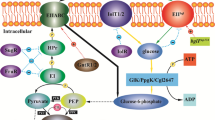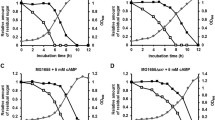Abstract
Pediococcus halophilus possesses phosphoenolpyruvate:mannose phosphotransferase system (man:PTS) as a main glucose transporter. A man:PTS defective (man:PTSd) strain X-160 could, however, utilize glucose. A possible glucose-transport mechanism other than PTS was studied with the strain X-160 and its derivative, man:PTSd phosphofructokinase defective (PFK−) strain M-13. Glucose uptake by X-160 at pH 5.5 was inhibited by any of carbonylcyanide m-chlorophenylhydrazone, nigericin, N,N′-dicyclohexylcarbodiimide, or iodoacetic acid. The double mutant M-13 could still transport glucose and accumulated intracellularly a large amount of hexose-phosphates (ca. 8 mM glucose 6-phosphate and ca. 2 mM fructose 6-phosphate). Protonophores also inhibited the glucose transport at pH 5.5, as determined by the amounts of accumulated hexose-phosphates (< 4 mM). These showed involvement of proton motive force (ΔP) in the non-PTS glucose transport. It was concluded that the non-PTS glucose transporter operated in concert with hexokinase or glucokinase for the metabolism of glucose in the man:PTSd strain.
Similar content being viewed by others
Abbreviations
- BM:
-
basal medium
- BM-G:
-
basal medium containing glucose
- CM:
-
complex medium
- man:PTS:
-
phosphoenolpyruvate:mannose phosphotransferase system
- CCCP:
-
carbonylcyanide m-chlorophenylhydrazone
- DCCD:
-
N,N′-dicyclohexyl carbodiimide
- ΔP:
-
proton motive force
- ΔpH:
-
transmembrane pH gradient
- Δφ:
-
transmembrane electrical potential difference
- MNNG:
-
N-methyl-N′-nitro-N-nitrosoguanidine
- PIPES:
-
piperazine-N,N′-bis(-ethanesulfonic acid)
- MES:
-
4-morpholineethanesulfonic acid
- G-6-P:
-
glucose 6-phosphate
- F-6-P:
-
fructose 6-phosphate
- FDP:
-
fructose 1,6-bisphosphate
- EMP:
-
Embden-Meyerhof-Parnas pathway
- PFK:
-
phosphofructokinase
- GK:
-
glucokinase
- HK:
-
hexokinase
- IAA:
-
iodoacetic acid
- IIman :
-
enzyme II component of man:PTS
References
AbeK, UchidaK (1989) Correlation between depression of catabolite control of xylose metabolism and a defect in phosphoenolpyruvate:mannose phosphotransferase system in Pediococcus halophilus. J Bacteriol 171:1793–1800
AbbeK, TakahashiS, YamadaT (1983) Purification and properties of pyruvate kinase from Streptococcus sanguis and activator specificity of pyruvate kinase from oral streptococci. Infect Immun 39:1007–1014
HamiltonIR (1987) Effects of changing environment on sugar transport and metabolism by oral bacteria. In: ReizerJ, PeterkofskyA (eds) Sugar transport and metabolism in Gram-positive bacteria. Ellis Horwood, Chichester, England, pp 94–133
HamiltonIR, St.MartinEJ (1982) Evidence for the involvement of proton motive force in the transport of glucose by a mutant of Streptococcus mutans strain DR0001 defective in glucose-phosphoenolpyruvate phosphotransferase activity. Infec Immun 36:567–575
HaroldFM (1972) Novel antibiotics as metabolic inhibitors. In: HochsterRM, KatesM, QuastelJH (eds) Metabolic inhibitors, vol 3: A comprehensive treatise. Academic Press, New York London, pp 305–360
HaroldFM (1977) Membranes and energy transduction in bacteria. In: SanadiDR (ed) Current topics in bioenergetics, vol 6. Academic Press, New York, pp 83–149
KashketER, BarkerSL (1977) Effects of potassium ions on the electrical and pH gradients across the membrane of Streptococcus lactis cells. J Bacteriol 130:1017–1023
KeevilCW, McDermidAS, MarshPD, EllwoodDC (1986) Protonmotive force driven 6-deoxyglucose uptake by the oral pathogen, Streptococcus mutans Ingbritt. Arch Microbiol 146:118–124
MaitraPK, EstabrookRW (1964) A fluorometric method for the enzymic determination of glycolytic intermediates. Anal Biochem 7:472–484
RomanoAH, TrifoneJD, BrustolonM (1979) Distribution of the phosphoenolpyruvate:glucose phosphotransferase system in fermentative bacteria. J Bacteriol 139:93–97
ThompsonJ, ChassyBM (1985) Intracellular phosphorylation of glucose analogs via the phosphoenolpyruvate: mannose phosphotransferase-system in Streptococcus lactis. J Bacteriol 162: 224–234
ThompsonJ, TorchiaDA (1984) Use of 31P nuclear magnetic resonance spectroscopy and 14C fluorography in studies of glycolysis and regulation of pyruvate kinase in Streptococcus lactis. J Bacteriol 158:791–800
UchidaK (1982) Multiplicity in soy pediococci carbohydrate fermentation and its application for analysis of their flora. J Gen Appl Microbiol 28:215–223
Author information
Authors and Affiliations
Rights and permissions
About this article
Cite this article
Abe, K., Uchida, K. Non-PTS uptake and subsequent metabolism of glucose in Pediococcus halophilus as demonstrated with a double mutant defective in phosphoenolpyruvate:mannose phosphotransferase system and in phosphofructokinase. Arch. Microbiol. 153, 537–540 (1990). https://doi.org/10.1007/BF00245262
Received:
Accepted:
Issue Date:
DOI: https://doi.org/10.1007/BF00245262




